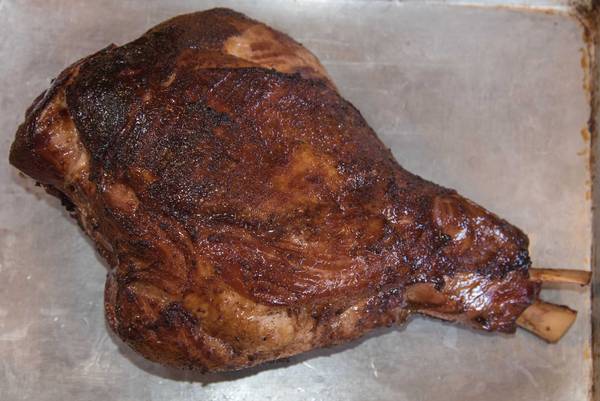Wet Cured Smoked Ham Recipe
4.1
(163)
Your folders
Your folders
Prep Time: 30 minutes
Cook Time: 720 minutes
Total: 10830 minutes
Servings: 30
Author : Kris Coppieters

Ingredients
Export 2 ingredients for grocery delivery
Instructions
Step 1
Prep. If your ham has skin, remove it and all the fat cap. You can use the skin to make cracklins. Skin and fat just do not add flavor. I debunk this myth in my article on fat caps. Besides, fat on a ham only slows the penetration of the cure and will get gelatinous after curing like this image.
Step 2
Get a 5 gallon (19.5 L) food grade bucket and clean the heck out of it first with soapy water. Rinse thoroughly with ounce (30 mL) of bleach per gallon (3.9 L) of water. Dry thoroughly. Then and add the distilled water, kosher salt, and Prague Powder #Stir til they dissolve. Chill it.
Step 3
Scrub the exterior of the ham thoroughly to remove as much bacteria as possible (don't use soap). Put the meat in the bucket and submerge it. If a piece of bone sticks out, get the hacksaw and cut it off or add more cure to cover it. If necessary, weight the meat down under a clean plastic container filled with water. Put the bucket in the refrigerator and let the meat cure for as long as the calculator tells you. If it is larger or smaller, use our curing calculator on this page to determine how long it needs to be in the cure. It must remain cold. After curing the water should remain transparent, but slightly pink, like this image.
Step 4
If you don't keep it in the brine long enough, you might have a tan spot that will taste like pork, not ham, like this one.
Step 5
Cook. After the cure, it is time to smoke. Before smoking, rinse the surface since there will be a heavier concentration of salt on there. If you wish, you can apply a salt free spice rub like my Meathead's Memphis Dust just before smoking. If you want to serve it immediately, and I strongly recommend it, smoke the ham at 325°F (163°C) until it is 145°F (63°C) in the deepest part of the center. This will take up to 5 hours depending on the meat's thickness. Rule of thumb: 30 minutes per inch of thickness at the thickest part. Your mileage may vary depending on a lot of variables such as your cooker's airflow, humidity, how much moisture in the meat, etc. The reason we cook at 325°F (163°C) is to prevent the stall which will happen at lower temperatures and that can result in a 12 hour or longer cook. During the last hour, paint it with a glaze. My favorite glazes are Chris Lilly's Spicy Apricot Glaze or Danny Gaulden's Brown Sugar Mustard Glaze. Make sure it doesn't burn. There is no substitute for a ham fresh from the smoker.
Step 6
If you don't plan to use it within a week, smoke it at 325°F (163°C) until it is 165°F (75°C) in the deepest part and it will be safe for up to two weeks in the fridge. Then when you reheat it cook it up to 145°F (63°C) and lay down your first layer of glaze when it hits about 130°F (54°C). Reheating can take almost as long as the initial smoking.
Step 7
Serve. Slice and serve immediately or refrigerate until ready to use. Leftovers can be stored in the refrigerator for a week or so, or frozen. If you vacuum seal, it will keep longer. You can cut slices and grill ham steaks, or just warm it in the oven. Also be sure to check out this video for our maple bacon recipe to learn even more about the curing process.